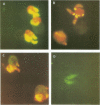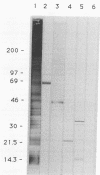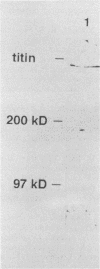Abstract
Cryptosporidium parvum, an Apicomplexan parasite of gastrointestinal epithelial cells, causes severe disease in persons with AIDS and is a common cause of self-limited diarrhea in children, animal handlers, and residents of developing countries. No approved therapy exists; in research studies, however, hyperimmune bovine colostrum raised to Cryptosporidium oocysts and sporozoites has eradicated disease or decreased parasite burden in some AIDS patients. Although the protective antigens recognized by bovine hyperimmune colostrum have not been defined, protective antigens of other Apicomplexan parasites frequently have been associated with two unique structures of invasive forms, the trilaminar pellicle and the apical complex. In order to identify immunogenic Cryptosporidium proteins that may be protective antigens for use as recombinant immunogens in passive and/or active immunotherapy, we screened two genomic DNA expression libraries with polyspecific anti-Cryptosporidium antibodies. We used an approach to cloning apical complex and pellicle protein antigens that succeeded despite the lack of large numbers of organisms that would be necessitated for conventional biochemical approaches requiring organelle or membrane purification. We report here the molecular cloning of five C. parvum genes and the characterization of the cognate sporozoite proteins having molecular masses of greater than 500, 68/95, 45, 23, and 15/35 kDa. The light microscopic immunofluorescence pattern of antibodies recognizing these protein antigens suggest that they are located in the pellicle or apical complex of Cryptosporidium sporozoites.
Full text
PDF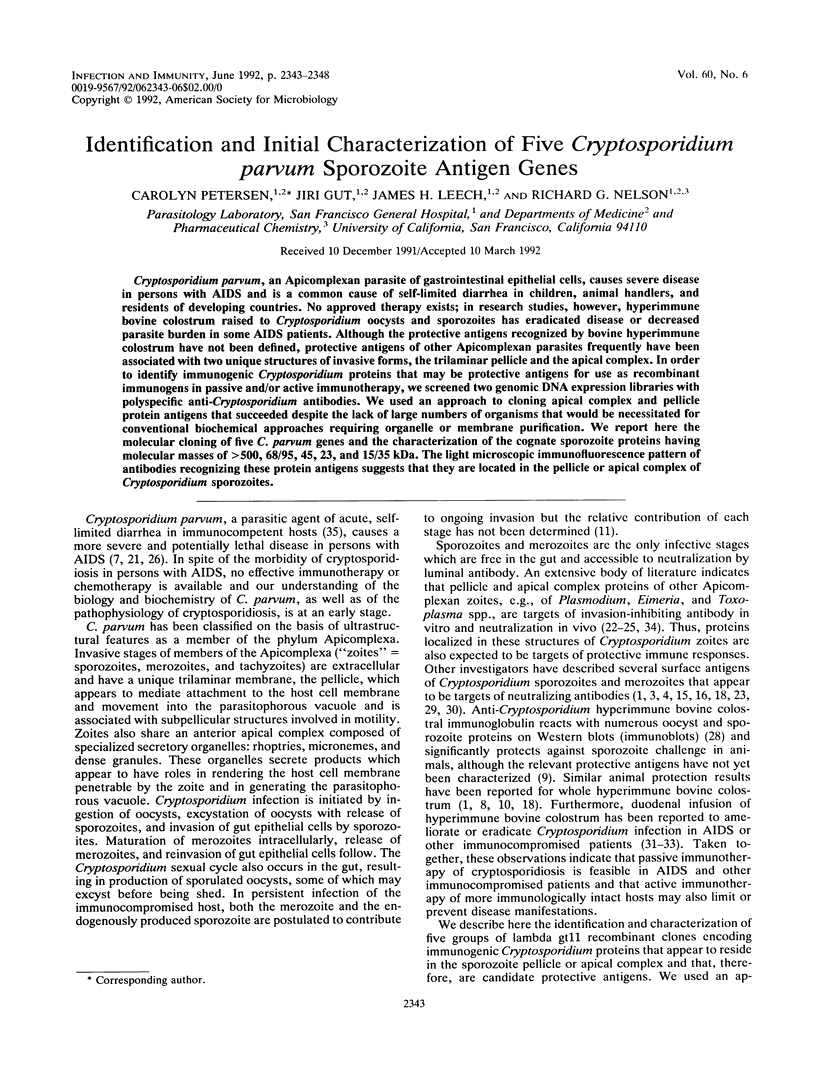
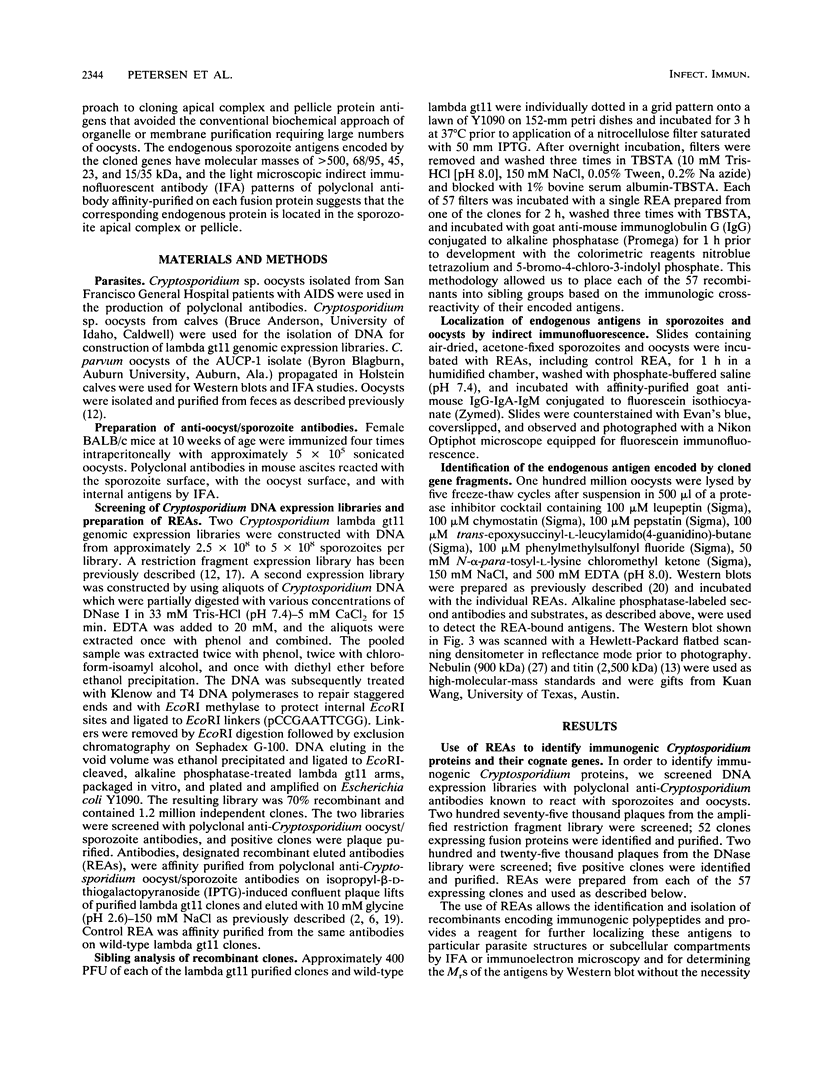
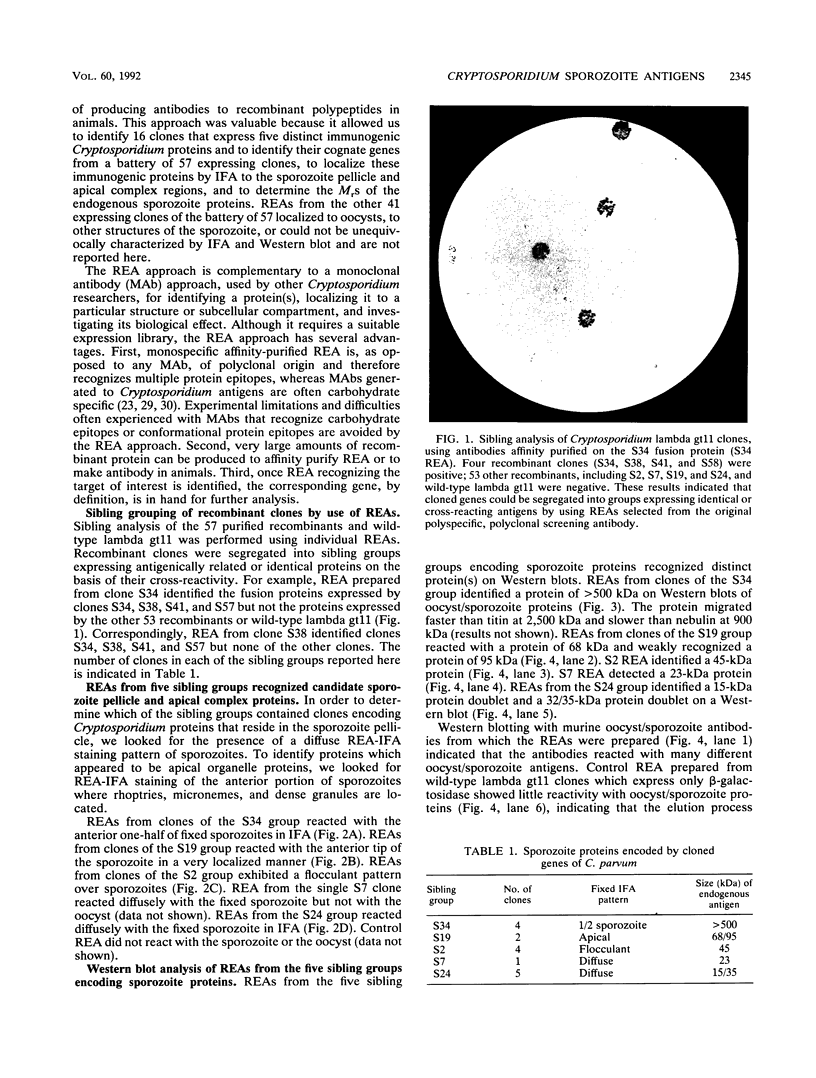
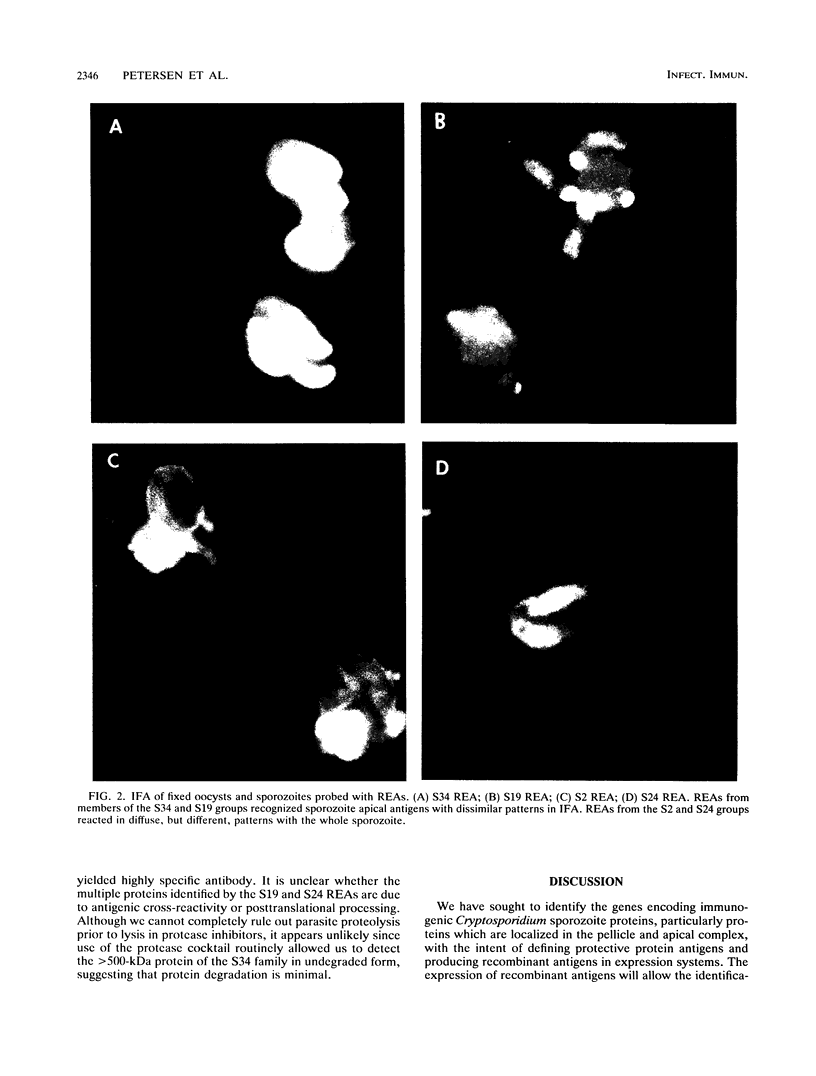
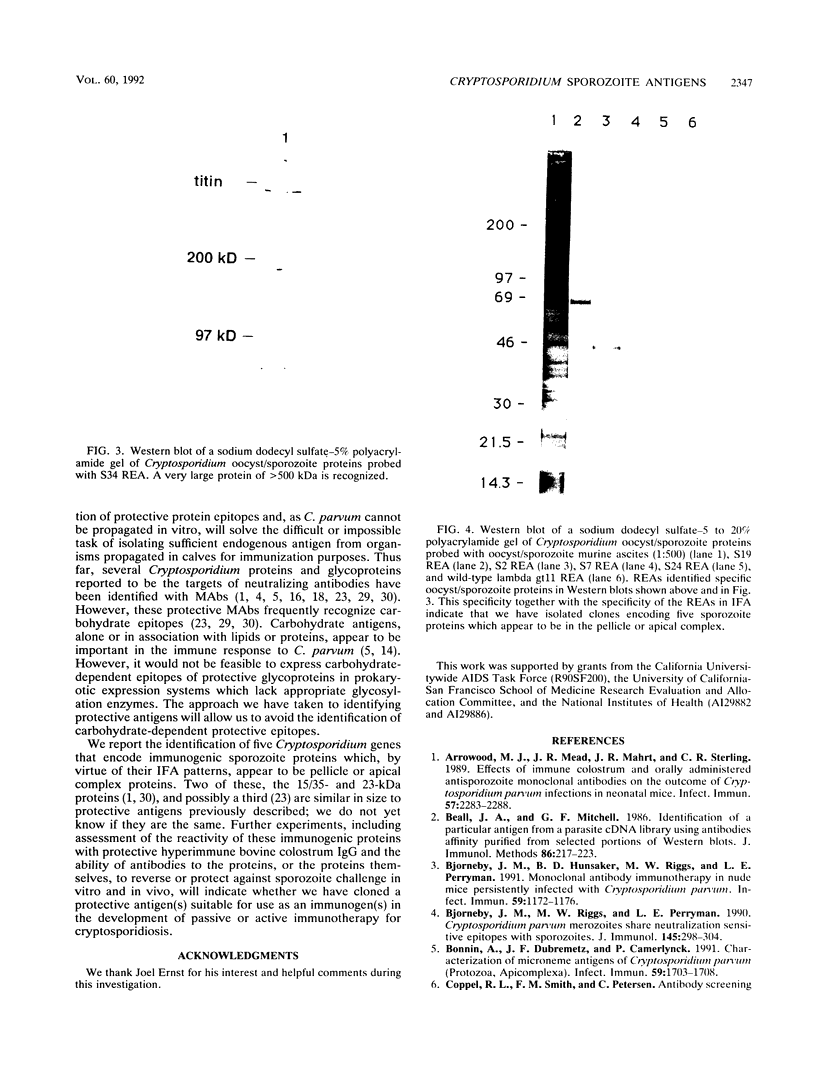
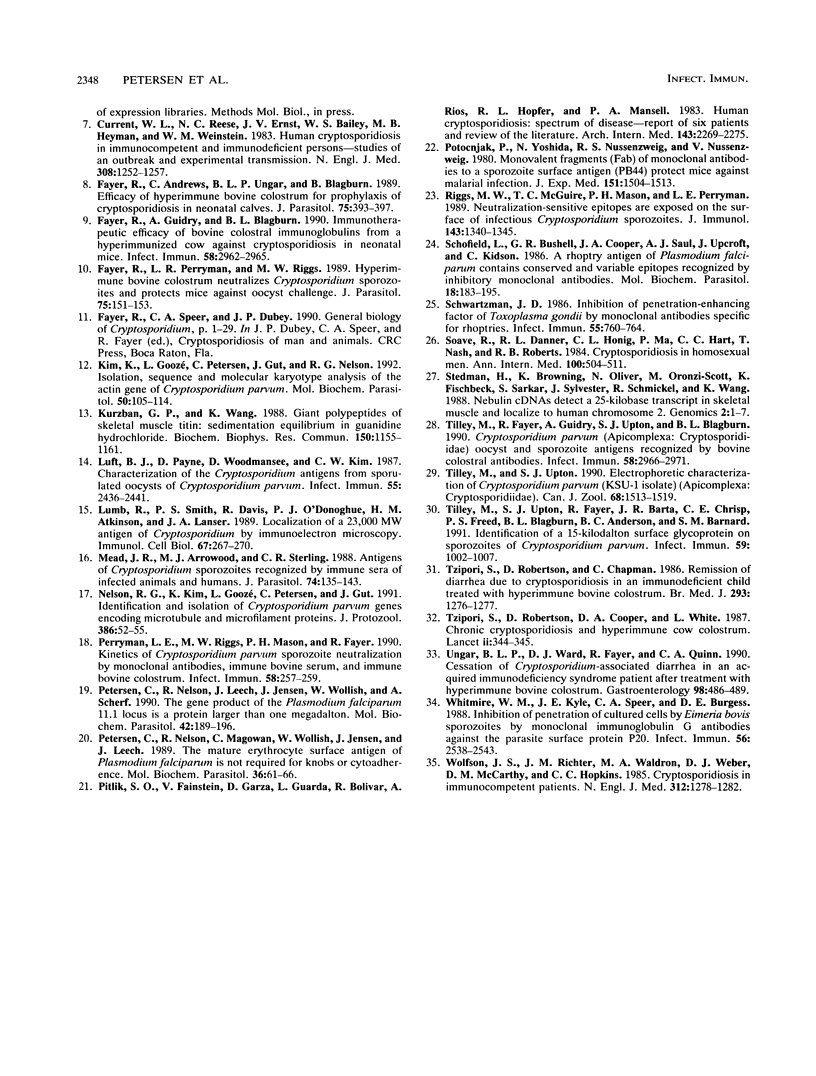
Images in this article
Selected References
These references are in PubMed. This may not be the complete list of references from this article.
- Arrowood M. J., Mead J. R., Mahrt J. L., Sterling C. R. Effects of immune colostrum and orally administered antisporozoite monoclonal antibodies on the outcome of Cryptosporidium parvum infections in neonatal mice. Infect Immun. 1989 Aug;57(8):2283–2288. doi: 10.1128/iai.57.8.2283-2288.1989. [DOI] [PMC free article] [PubMed] [Google Scholar]
- Beall J. A., Mitchell G. F. Identification of a particular antigen from a parasite cDNA library using antibodies affinity purified from selected portions of Western blots. J Immunol Methods. 1986 Feb 12;86(2):217–223. doi: 10.1016/0022-1759(86)90456-4. [DOI] [PubMed] [Google Scholar]
- Bjorneby J. M., Hunsaker B. D., Riggs M. W., Perryman L. E. Monoclonal antibody immunotherapy in nude mice persistently infected with Cryptosporidium parvum. Infect Immun. 1991 Mar;59(3):1172–1176. doi: 10.1128/iai.59.3.1172-1176.1991. [DOI] [PMC free article] [PubMed] [Google Scholar]
- Bjorneby J. M., Riggs M. W., Perryman L. E. Cryptosporidium parvum merozoites share neutralization-sensitive epitopes with sporozoites. J Immunol. 1990 Jul 1;145(1):298–304. [PubMed] [Google Scholar]
- Bonnin A., Dubremetz J. F., Camerlynck P. Characterization of microneme antigens of Cryptosporidium parvum (Protozoa, Apicomplexa). Infect Immun. 1991 May;59(5):1703–1708. doi: 10.1128/iai.59.5.1703-1708.1991. [DOI] [PMC free article] [PubMed] [Google Scholar]
- Current W. L., Reese N. C., Ernst J. V., Bailey W. S., Heyman M. B., Weinstein W. M. Human cryptosporidiosis in immunocompetent and immunodeficient persons. Studies of an outbreak and experimental transmission. N Engl J Med. 1983 May 26;308(21):1252–1257. doi: 10.1056/NEJM198305263082102. [DOI] [PubMed] [Google Scholar]
- Fayer R., Andrews C., Ungar B. L., Blagburn B. Efficacy of hyperimmune bovine colostrum for prophylaxis of cryptosporidiosis in neonatal calves. J Parasitol. 1989 Jun;75(3):393–397. [PubMed] [Google Scholar]
- Fayer R., Guidry A., Blagburn B. L. Immunotherapeutic efficacy of bovine colostral immunoglobulins from a hyperimmunized cow against cryptosporidiosis in neonatal mice. Infect Immun. 1990 Sep;58(9):2962–2965. doi: 10.1128/iai.58.9.2962-2965.1990. [DOI] [PMC free article] [PubMed] [Google Scholar]
- Fayer R., Perryman L. E., Riggs M. W. Hyperimmune bovine colostrum neutralizes Cryptosporidium sporozoites and protects mice against oocyst challenge. J Parasitol. 1989 Feb;75(1):151–153. [PubMed] [Google Scholar]
- Kim K., Goozé L., Petersen C., Gut J., Nelson R. G. Isolation, sequence and molecular karyotype analysis of the actin gene of Cryptosporidium parvum. Mol Biochem Parasitol. 1992 Jan;50(1):105–113. doi: 10.1016/0166-6851(92)90248-i. [DOI] [PubMed] [Google Scholar]
- Kurzban G. P., Wang K. Giant polypeptides of skeletal muscle titin: sedimentation equilibrium in guanidine hydrochloride. Biochem Biophys Res Commun. 1988 Feb 15;150(3):1155–1161. doi: 10.1016/0006-291x(88)90750-4. [DOI] [PubMed] [Google Scholar]
- Luft B. J., Payne D., Woodmansee D., Kim C. W. Characterization of the Cryptosporidium antigens from sporulated oocysts of Cryptosporidium parvum. Infect Immun. 1987 Oct;55(10):2436–2441. doi: 10.1128/iai.55.10.2436-2441.1987. [DOI] [PMC free article] [PubMed] [Google Scholar]
- Lumb R., Smith P. S., Davies R., O'Donoghue P. J., Atkinson H. M., Lanser J. A. Localization of a 23,000 MW antigen of Cryptosporidium by immunoelectron microscopy. Immunol Cell Biol. 1989 Aug;67(Pt 4):267–270. doi: 10.1038/icb.1989.40. [DOI] [PubMed] [Google Scholar]
- Mead J. R., Arrowood M. J., Sterling C. R. Antigens of Cryptosporidium sporozoites recognized by immune sera of infected animals and humans. J Parasitol. 1988 Feb;74(1):135–143. [PubMed] [Google Scholar]
- Perryman L. E., Riggs M. W., Mason P. H., Fayer R. Kinetics of Cryptosporidium parvum sporozoite neutralization by monoclonal antibodies, immune bovine serum, and immune bovine colostrum. Infect Immun. 1990 Jan;58(1):257–259. doi: 10.1128/iai.58.1.257-259.1990. [DOI] [PMC free article] [PubMed] [Google Scholar]
- Petersen C., Nelson R., Leech J., Jensen J., Wollish W., Scherf A. The gene product of the Plasmodium falciparum 11.1 locus is a protein larger than one megadalton. Mol Biochem Parasitol. 1990 Sep-Oct;42(2):189–195. doi: 10.1016/0166-6851(90)90161-e. [DOI] [PubMed] [Google Scholar]
- Petersen C., Nelson R., Magowan C., Wollish W., Jensen J., Leech J. The mature erythrocyte surface antigen of Plasmodium falciparum is not required for knobs or cytoadherence. Mol Biochem Parasitol. 1989 Aug;36(1):61–65. doi: 10.1016/0166-6851(89)90200-4. [DOI] [PubMed] [Google Scholar]
- Pitlik S. D., Fainstein V., Garza D., Guarda L., Bolivar R., Rios A., Hopfer R. L., Mansell P. A. Human cryptosporidiosis: spectrum of disease. Report of six cases and review of the literature. Arch Intern Med. 1983 Dec;143(12):2269–2275. doi: 10.1001/archinte.1983.00350120059015. [DOI] [PubMed] [Google Scholar]
- Potocnjak P., Yoshida N., Nussenzweig R. S., Nussenzweig V. Monovalent fragments (Fab) of monoclonal antibodies to a sporozoite surface antigen (Pb44) protect mice against malarial infection. J Exp Med. 1980 Jun 1;151(6):1504–1513. doi: 10.1084/jem.151.6.1504. [DOI] [PMC free article] [PubMed] [Google Scholar]
- Riggs M. W., McGuire T. C., Mason P. H., Perryman L. E. Neutralization-sensitive epitopes are exposed on the surface of infectious Cryptosporidium parvum sporozoites. J Immunol. 1989 Aug 15;143(4):1340–1345. [PubMed] [Google Scholar]
- Schofield L., Bushell G. R., Cooper J. A., Saul A. J., Upcroft J. A., Kidson C. A rhoptry antigen of Plasmodium falciparum contains conserved and variable epitopes recognized by inhibitory monoclonal antibodies. Mol Biochem Parasitol. 1986 Feb;18(2):183–195. doi: 10.1016/0166-6851(86)90037-x. [DOI] [PubMed] [Google Scholar]
- Schwartzman J. D. Inhibition of a penetration-enhancing factor of Toxoplasma gondii by monoclonal antibodies specific for rhoptries. Infect Immun. 1986 Mar;51(3):760–764. doi: 10.1128/iai.51.3.760-764.1986. [DOI] [PMC free article] [PubMed] [Google Scholar]
- Soave R., Danner R. L., Honig C. L., Ma P., Hart C. C., Nash T., Roberts R. B. Cryptosporidiosis in homosexual men. Ann Intern Med. 1984 Apr;100(4):504–511. doi: 10.7326/0003-4819-100-4-504. [DOI] [PubMed] [Google Scholar]
- Stedman H., Browning K., Oliver N., Oronzi-Scott M., Fischbeck K., Sarkar S., Sylvester J., Schmickel R., Wang K. Nebulin cDNAs detect a 25-kilobase transcript in skeletal muscle and localize to human chromosome 2. Genomics. 1988 Jan;2(1):1–7. doi: 10.1016/0888-7543(88)90102-4. [DOI] [PubMed] [Google Scholar]
- Tilley M., Fayer R., Guidry A., Upton S. J., Blagburn B. L. Cryptosporidium parvum (Apicomplexa: Cryptosporidiidae) oocyst and sporozoite antigens recognized by bovine colostral antibodies. Infect Immun. 1990 Sep;58(9):2966–2971. doi: 10.1128/iai.58.9.2966-2971.1990. [DOI] [PMC free article] [PubMed] [Google Scholar]
- Tilley M., Upton S. J., Fayer R., Barta J. R., Chrisp C. E., Freed P. S., Blagburn B. L., Anderson B. C., Barnard S. M. Identification of a 15-kilodalton surface glycoprotein on sporozoites of Cryptosporidium parvum. Infect Immun. 1991 Mar;59(3):1002–1007. doi: 10.1128/iai.59.3.1002-1007.1991. [DOI] [PMC free article] [PubMed] [Google Scholar]
- Tzipori S., Roberton D., Chapman C. Remission of diarrhoea due to cryptosporidiosis in an immunodeficient child treated with hyperimmune bovine colostrum. Br Med J (Clin Res Ed) 1986 Nov 15;293(6557):1276–1277. doi: 10.1136/bmj.293.6557.1276. [DOI] [PMC free article] [PubMed] [Google Scholar]
- Tzipori S., Roberton D., Cooper D. A., White L. Chronic cryptosporidial diarrhoea and hyperimmune cow colostrum. Lancet. 1987 Aug 8;2(8554):344–345. doi: 10.1016/s0140-6736(87)90944-5. [DOI] [PubMed] [Google Scholar]
- Ungar B. L., Ward D. J., Fayer R., Quinn C. A. Cessation of Cryptosporidium-associated diarrhea in an acquired immunodeficiency syndrome patient after treatment with hyperimmune bovine colostrum. Gastroenterology. 1990 Feb;98(2):486–489. doi: 10.1016/0016-5085(90)90842-o. [DOI] [PubMed] [Google Scholar]
- Whitmire W. M., Kyle J. E., Speer C. A., Burgess D. E. Inhibition of penetration of cultured cells by Eimeria bovis sporozoites by monoclonal immunoglobulin G antibodies against the parasite surface protein P20. Infect Immun. 1988 Oct;56(10):2538–2543. doi: 10.1128/iai.56.10.2538-2543.1988. [DOI] [PMC free article] [PubMed] [Google Scholar]
- Wolfson J. S., Richter J. M., Waldron M. A., Weber D. J., McCarthy D. M., Hopkins C. C. Cryptosporidiosis in immunocompetent patients. N Engl J Med. 1985 May 16;312(20):1278–1282. doi: 10.1056/NEJM198505163122002. [DOI] [PubMed] [Google Scholar]




